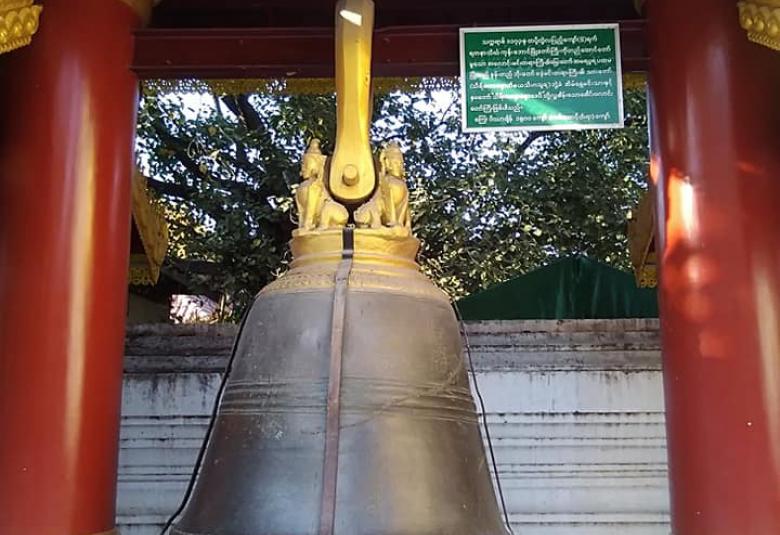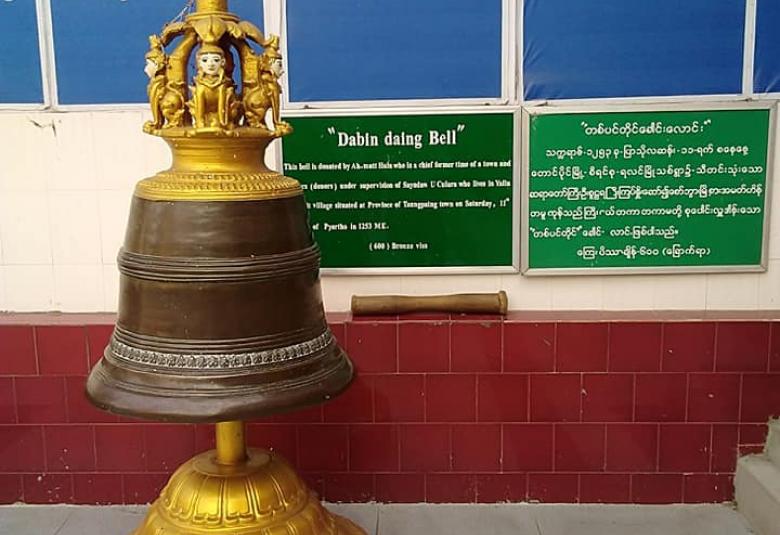26 Sep
Maha Muni Buddha Image, the symbol of Mandalay City, takes a position in Kyunlon Okshaung Ward of Chanmyathazi Township. The Buddha image is named Maha Myat Muni as well as Phayagyi. Actual title of the image is Maha Muni. The image arrived in Mandalay in 1784 in the reign of King Bodaw who established Amarapura City.
The image is 12 feet and seven inches in height, 9.5 feet in diameter at waist, four feet and 11 inches in diameter at arm and six feet and one inch in width between the two shoulders. The sitting image cast of 6.5 tonnes of bronze is in Bhumi Phassa Mudra.
Maha Muni
King Bodaw constructed a golden building on which nine tiers were hoisted on the plain for the image, 1,000 tars north of Amarapura Royal Palace. Kings, queens, royal families and court officials had donated gold forehead, gold headdress, golden stairways and golden public rest houses in successive eras. The Maha Muni Buddha image, stairways and tier-roofed building were ablaze on 7 April 1884.
The fire destroyed a gold headdress, gold earring, gold sash and gold foils but the image structure escaped from burning. Gold melting from the structure of the image was collected and it weighed 5,450 but its unit was not mentioned in the record. New headdress was offered to the image on 23 June 1884.
King Thibaw offered the gold plates weighing 60 viss made of the melt gold foil from the fire to the Buddha image on 16 January 1885.
The new tier-roofed building was constructed of brick and concrete in 1260 ME. The umbrella hoisted atop in the building fell down on the ground in strong wind in 1278 ME. So, Yaksawk Saopha hoisted new umbrella atop the building.
Taungtaw Sangharaja Sayadaw, Sudhamma Sayadaws and Kinwun Mingyi took responsibilities for management of the Buddha image. The key of Gandakuti Chamber was handed over to Shweyay Hall Sayadaw U Nanda for washing the face of the image in 1248 ME. As of 1st waxing of Tabaung, 1349 ME, Bhaddanta Pannavamsa of Pitakattaik Monastery from South Htilin Building started washing the face of image every morning.
The first financial board of trustees was formed for the Buddha image in 1891. On 27 June 1894, the Commissioner of Engineering, the Assistant Engineer and Clerk U Yaw laid cornerstone for construction of Gandakuti Chamber. It was built by Kinwun Mingyi and European engineers in 1896.
On 12 February 1900, U Phe repaired the throne for the Buddha image and backdrops. He also repaired the headdress donated by King Thibaw on 20 February 1902 and offered new headdress decorated with 940 pieces of jewellery to the image. On 12 July 1908, a gold sash decorated with nine kinds of jewellery weighing 13 viss and 60 ticals was offered to the image. A diamond orb made of gold weighing 19 ticals was hoisted atop the building by Nyaungshwe Saopha Sir Sao Maung in 1918.
As number of pilgrims to the Buddha image was on the increase, hermit U Khanti built a brick stairway between Maha Muni Buddha image and Ananda ordination hall on 29 January 1931.
As a gesture of hailing the 2500th anniversary of the Buddha Sasana, Sankin Sayadaw, Nyaungyan Sayadaw, Khemathiwun Sayadaw and Hanthawady Sayadaw laid cornerstones for Yadana Beikman building in 1956 and it was commissioned into service on 14 April 1957. The wooden backdrop of the image was donated in 1932-33.
The prayer hall of the image was built from 1942 to 1948, and more than 30 members of the Sangha led by U Jotika maintained objects of the image. The statue of crown prince who conveyed the image was kept on the platform between southern and eastern archways in 1948.
The central tower was constructed at the northeast corner of the image on 28 May 1959 in commemoration of the centennial anniversary of Yadanabon Mandalay City. Then, Nyeinchan Thayar triangular bronze gong weighing 3,264 viss was cast on 31 December 1965 and Chanaye Pyitha bronze gong weighing 2,156 viss cast in 1972.
In the precinct, two man statues, three lion statues and an Ayeyawun elephant statue with three heads made of bronze were taken by King Bayintnaung from Yodaya. A war happened between King Nanda, son of King Bayintnaung, and the governor of Toungoo. After conquering King Nanda, the governor of Toungoo gave these bronze statues as gifts to Rakhine King for compensation of reinforcements. So, these statues were taken to Rakhine State, according to Myanmar Encyclopaedia.
King Bayintnaung arrived back in Bago on 18 May 1564 after conquering Yodaya, according to Twinthin New History Volume II. The statues taken by King Bayintnaung went to Rakhine when Hanthawady royal palace deteriorated. In Konbaung era, these statues reached Amarapura.
Thirty bronze statues conveyed along with Maha Muni Buddha image were kept at the ordination hall built by Thiri Thusanda Devi, wife of Yintaung governor, southeast of Maha Muni Buddha image precinct. These statues were stored in the tier-roofed building of Ananda Temple called red ordination hall but collapse of the building caused damage to the statues.
People said that these statues came from Angkor city of Cambodia and two human statues were King Pyatha Dhipati and queen of Yodaya but some said these statues depicted gods from Yodaya. These statues are displayed in the precinct of the image. Some people believe if one gives a message to or push the statues, one would have good health. As the statues were damaged in touch of the people, these statues were kept in the glass chamber.
Maha Muni in Pali means great Lord Buddha in English. As the image is an ancient one related to Buddhism, successive preservation of Myanmar people has been undertaken for public obeisance till today.
Holy bells at Maha Muni Buddha Image
Once, bells were kept in a row along the west wall of the precinct. In casting the great triangular gong and god statues, these bells were smelt. As such, invaluable historical records lost. Currently, there remain 24 bells on the platform of the image, 18 of which were impressed bell inscriptions. Most of the bells are weighing 100-150 viss of bronze. Among them, 12 bells were impressed records on dates of casting.
Among these bells, the Crown Prince bell located on the northwest platform and Tapintaing bell on the eastern bell are very famous.
The Crown Prince bell was cast by Crown Prince Thiha Thura. In 1811 after the Crown Prince passed away, one of his wives Nanda Devi donated the bell to Maha Muni Buddha Image. Mingun Bell was hung in 1810. One year later, the Crown Prince bell was hung.
Cracks of the bell were welt and it was rapped with an iron strap for long term existence. The bell weighed more than 1,500 viss, and its mouth was six feet and eight inches in width. The surface area of the bell with six feet in length and one foot and four inches in width was impressed with 17 lines of inscriptions.
The bell inscription mentioned records of its casting and praying. It mentioned the title of King Alaungmintaya who established Konbaung Dynasty as donor of Sasana Lawkadhipati. The full text of the bell inscription can be seen in the book on history of Mandalay Maha Muni Buddha Image compiled by U Maung Maung Tin.
The bell kept near the eastern archway of the platform is not similar to other bells hung at the bar. It was linked at a post, called Tapintaing bell. Nine lines of inscriptions on the bell mentioned the date of casting it with the use of 600 viss of bronze on 11th waxing of Pyatho, 1253 ME, Saturday.
Under the supervision of Sayadaw U Culara residing in Yalin Myothit Village of Taungpaing District, the bell was cast by spending K1,500 contributed by members of the Sangha from Taungpaing City, Saopha cum city governor counsellor Hein, merchants and disciples.
Two holy bronze bells, called Crown Prince bell and Tapintaing Bell on the platform of Maha Muni Buddha Image bearing invaluable historical records are intangible cultural heritages for Myanmar, so it is necessary to preserve these objects for observation of new generations.
By Maung Tha (Archaeology) (Translated by Than Tun Aung)




